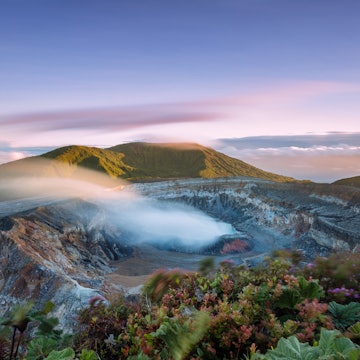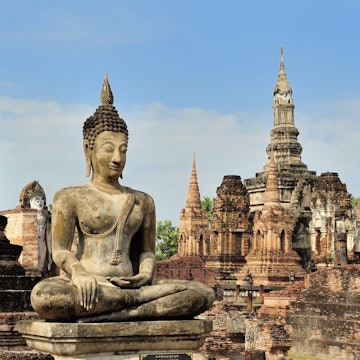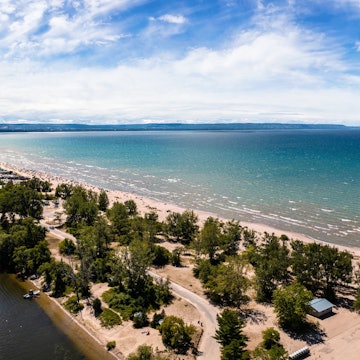
Responsible outdoor excursions in Croatia this fall
Sponsored by
Nov 9, 2020 • 5 min read

Kopacki rit is one of the largest wetland areas in Europe and the perfect Autumn spot for wildlife-watching © Ivo Biočina / Croatian National Tourist Board
When the world again begins to travel, Croatia is the ideal place to reconnect with the wild. The country’s beautiful beaches and vibrant cities are well-known, and rank among Europe’s most appealing. But the changed reality of travel due to the coronavirus pandemic – the need for sustainability and social distancing – means a different kind of attraction is needed. And fortunately, Croatia is well-prepared.
Like so much of wild Europe, Croatia’s stirring natural beauty has been able to breathe and regenerate in preparation for our return. And the fall, with its gorgeous colors and smaller number of visitors, is the perfect time to visit.

Plitvice Lakes
There’s nowhere in Europe quite like Plitvice Lakes. A UNESCO World Heritage-listed site since 1979, this extraordinary place is filled with blue lakes and waterfalls, a world in motion that in the fall is offset by the greens and golds of the surrounding forests. Everything here in Plitvice is postcard-pretty. But it’s the water flowing through porous limestone to connect lakes of all sizes and shapes, the interplay of a colour palette most vivid in the fall, that give Plitvice Lakes its charm.
The lower lakes are the heart and soul of Plitvice’s appeal, with towering stands of trees, caves, and cliffs, and even Croatia’s tallest waterfall – 255-foot-high Veliki Slap. Other highlights are everywhere, from emerald Milanovac Lake to the wild ducks of reed-fringed Gradinsko and Kaluđerovac lakes. Deeper into the network of lakes, the trails that connect them become quieter and lead to the upper lakes. There’s stunning Galovac Lake, where natural travertine has triumphed over concrete. You could spend hours enjoying larger Okrugljak Lake with its splendid cascades stirring up the lake’s surface. But at this time of year, there’s nothing to compare with Prošćansko Lake, encircled by dense autumnal forests.
Perhaps best of all, the lake system can be explored on foot, ensuring your impact on the landscape is minimal. If you’re lucky and quiet, you might even see bears or boars or badgers.

Papuk
In an era when everyone has a smartphone, no wild and beautiful place can remain a secret for long. Which is why Papuk is such a remarkable place.
At once a nature park and a UNESCO geopark, Papuk is quite the discovery and is barely known outside Croatia. Papuk lies deep in the mountain valleys of Slavonia, a natural site of astonishing beauty. Medieval ruins cling to mountain summits like signposts to an altogether more epic past. Ancient beech forests, animated by streams and waterfalls and given a sense of mystery by atmospheric caves, transform into a sea of reds and oranges and yellows in the fall. And at Rupnica, geology becomes a source of wonder thanks to the bizarre stone pillars and rock mosaics that were created when a long-disappeared volcano wrought its terrible fury upon the land.
As with Plitvice Lakes, Papuk is perfectly suited for hiking. And if you visit on a weekday, you might have these trails to yourself.

Kopački Rit and Lonjsko Polje
Fall is precisely when you should visit Kopački rit and Lonjsko polje, two of the most rewarding attractions of the Croatian interior.
During autumn, birds begin arriving in Kopački rit, just 7.5 miles northeast of Osijek, on their annual migration from Africa to this, one of the largest wetland areas in Europe. Along with resident bird species, these yearly visitors bring the number of species recorded here to almost 300. The most sought-after prize for birders is undoubtedly the rare black stork, but white-tailed eagles, great crested grebes, and purple herons also prompt cries of excitement.
Suitably for such an aquatic environment, boat tours led by expert wildlife guides and operated under strict safety and health guidelines, are the best way to get around. Even so, renting a bicycle is even more environmentally friendly and much more conducive to social distancing. A bicycle means you can explore the glorious variety of habitats, from grasslands to poplar, willow, and oak forests.
Birds are also the major reason to visit Lonjsko Polje, a more-than-310-square-mile expanse of swampland in the Posavina region. Storks crowd the medieval towers of surrounding villages in spring and summer, and, depending on the year, some linger into early fall. Čigoć is the best-known village in the area, a charming place of wooden houses and stork nests that the birds return to year after year. Just as beautiful is Krapje, or Mužilovčica, known for its skies filled with swallows. And while you’re here, hire a bike and ride out into the oak forests to look for the posavski horse, a local breed you can’t see anywhere else.

Northern Velebit
In some ways, we’ve saved the best until last.
Separating Croatia’s inland from the sublime Adriatic coast, the Velebit Mountains rise with stark and austere beauty from the narrow coastal strip. Generations of beachgoers and visitors to the islands of the Adriatic know these mountains as the backdrop to so many memorable views, framing crystalline seas and stone-and-terracotta villages along the coast. Few realise that the mountains themselves are worthy destinations in their own right.
Paklenica National Park is where so many journeys into the Velebit range begin. The park’s centerpiece is two deep, dramatic gorges, Velika Paklenica (Great Paklenica) and Mala Paklenica (Small Paklenica). Whether you view them from high on the rim or down in the shadows, it can be impossible to take your eyes off the vertigo-inducing cliffs, more than 1,300 feet high; watch for golden eagles and peregrine falcons riding high on the thermals. Elsewhere, forests of beech, pine, and oak contrast with the dry limestone karst, while chamois can usually be seen close to the park entrance.
And while you could visit the northern Velebit mountains at other times of the year, visiting in the fall means you avoid both the summer heat and the bura, a cold north-easterly wind that scours the range in winter, bringing rain and sudden storms. Instead you’ll encounter a land tinged with green, mild temperatures, and quiet hiking trails through this remarkable landscape.
You might also like
Why food and culture fans need to explore inland Croatia
Two blissful weeks on the water from Dubrovnik to Split
Sponsored by Croatian National Tourist Board
As a travel entertainment and inspirational media outlet, we sometimes incorporate brand sponsors into our efforts. This activity is clearly labeled across our platforms.
This story was crafted collaboratively between Croatian National Tourist Board and Lonely Planet. Both parties provided research and curated content to produce this story. We disclose when information isn’t ours.
With sponsored content, both Lonely Planet and our brand partners have specific responsibilities:
-
Brand partner
Determines the concept, provides briefing, research material, and may provide feedback.
-
Lonely Planet
We provide expertise, firsthand insights, and verify with third-party sources when needed.















